‘Behemoth’ is a word which springs to mind or, perhaps more nautically, ‘leviathan’.
- Space and stability
- Electric davit for the tender
- Easy flow between cockpit, saloon and foredeck
- Feels sturdy and solid
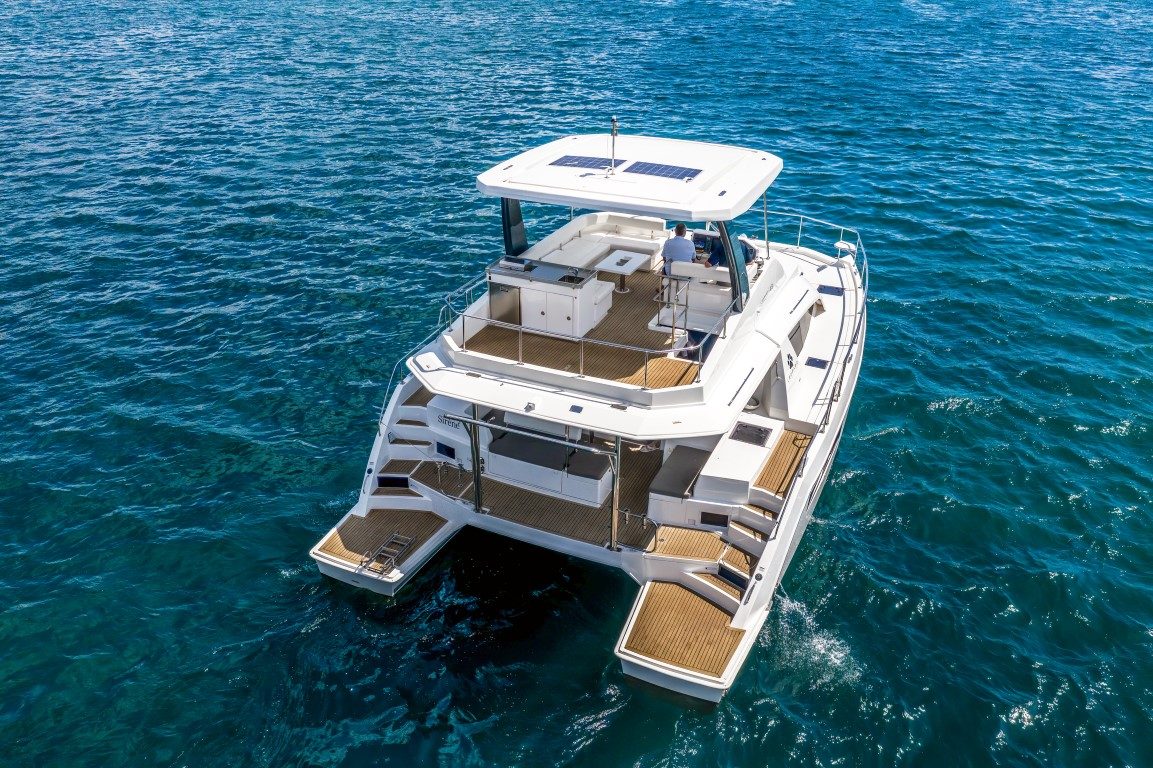
When you have a large, extended family of boaties, the best way to celebrate special occasions is on a comfy, spacious platform that accommodates everyone’s needs. The Leopard 43’s a sleek solution.
The Leopard 43 is built by South Africa’s Robertson & Caine – that country’s largest boatbuilder – and Sirène is the second of the model in New Zealand. She belongs to Hamilton’s Wayne and Helen Giles who moor her at their bach on the Whitianga Waterways, the ideal launch pad to the glorious cruising ground that is the Coromandel.
They’re more than delighted with her – for multiple reasons – not the least of which is her space and the ability to host the entire whanau over Christmas. But absolutely the best part for her, says Helen, is the stability: “Some years ago I used to take ‘Paihia Bombs’ to combat seasickness – I think they worked because they made me ‘float’ across the decks. But I’ve not once felt the need for medication on Sirène – she’s very kind to me.”
As seasoned cat enthusiasts (they’ve owned one before) the couple conducted a rigorous investigation into different marques before signing the Leopard contract – a research project that included a visit to the company’s Cape Town factory. They found much to admire about the vessel’s build process and features – all of which was quickly corroborated when they took delivery of her late last year.
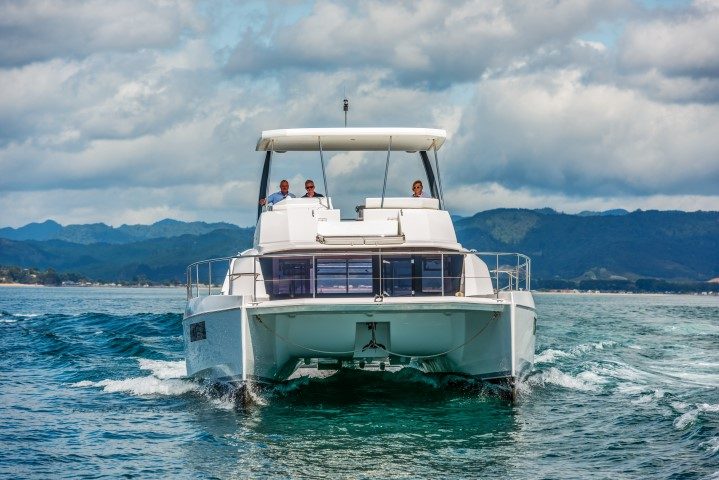
Let’s begin with performance.
Penned by Netherlands’ Simonis Voogd Design, the cat’s easy motion is the synthesis of various features – among them the sleek hulls with knife-like bows, a long waterline length, minimal drag, plenty of buoyancy fore and aft, and engines positioned relatively far forward.
With a shallow draft and modest wetted area the hulls reward owners with slippery fuel-efficiency – those fine bows scythe through the water. This is aided by a long waterline: designed with plumb bows and long boarding platforms aft, the LWL is just shy of her 13m LOA.
Each hull also carries hard chines just above the waterline. This extra width not only creates more volume for accommodation inside, but also improves buoyancy in boisterous seas. And where many cats have their engines located right in the sterns, the 43’s are mounted further forward – a happier weight distribution to minimise any porpoising or ‘hobby-horsing’.
Robertson & Caine’s major client is the charter market and the 43 is available with different engine options. Charter models are often fitted with 200hp engines – Sirène’s owners have opted for a pair of twin-turbo, 320hp Yanmar V8s.

These drive her to a top speed of 24 knots, but at a Frank Sinatra croon speed (16 knots @ 2,800rpm) the V8s together consume around 72 litres/hour. With the 1000-litre fuel capacity (2 x 500 litres), the Giles are likely to run out of wine long before fuel on an extended cruise.
The Yanmars live under the double beds in the aft cabins, accessed by raising the bed bases (these have electrically-operated struts), and though space is fairly restricted, filters and other service points are within easy reach.
Engine boxes are well-insulated so the rumble is relatively muted and virtually inaudible from the flybridge. But my favourite Yanmar treat? The fly-by-wire throttles/shifts – they’re chocolate-smooth and a pleasure when maneuvering the cat into tight spots. Mounted some six metres apart, the engines pretty much rotate Sirène within her own length. A rear-facing video camera – interfacing with the Raymarine MFD – displays the approaching quay in frightening detail when backing-up.
Deck Spaces
There are three discrete outside areas – a vast cockpit, a massive foredeck and the flybridge – each with distinctive attractions. You could have a party in any of them but, more importantly, when the boat’s swarming with rellies each area can host a different age group. I suggest the adults grab the cockpit – it’s closer to the food/fridges and the Fusion stereo system’s master volume control. Not everyone likes Rap at 200dB.
The cockpit’s dominated by a spacious U-shaped settee around a large table, with an additional bench seat down the starboard side. Between them is a walkway to the aft platform. The aft leg of the main settee is a particularly clever piece of design – it has a pivoting backrest.
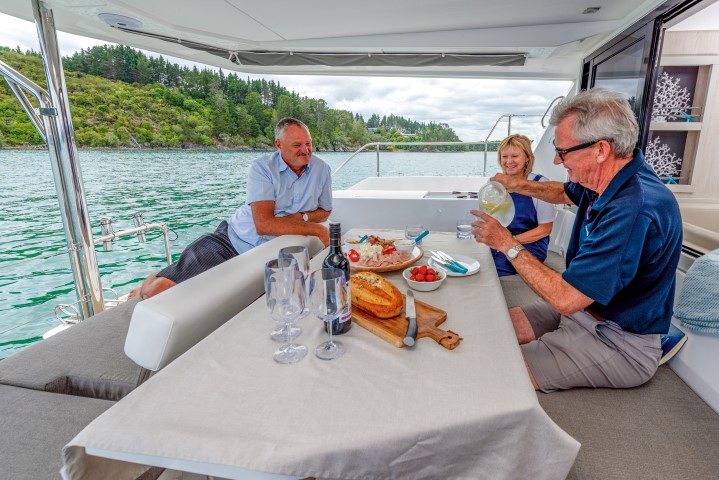
In conversation/dinner mode, when you’re facing the table, the backrest’s oriented aft. But if you’re watching the lures – or simply contemplating your embarrassing indiscretions at last night’s party – flick the backrest the other way. It’s really comfy – more chaise longue than settee. The large overhang keeps the area shady and cool and, if the weather turns, there are drop-down clears.
Under all cushions are vast storage lockers – only a few among the multitude of clever storage areas found throughout the vessel.
Cockpit geometry feeds naturally to the aft platform and, from there, down two steps either side to those generous boarding platforms. They’re about 1.5m long and almost as wide – each a great possie for catching a few rays. Cockpit, aft platform and boarding platforms are covered in hard-wearing/easy-to-clean faux (composite) teak. Very nautical and it looks great. Remember to wash off the sunscreen before going back inside – there’s a freshwater, pull-out shower at the port platform.
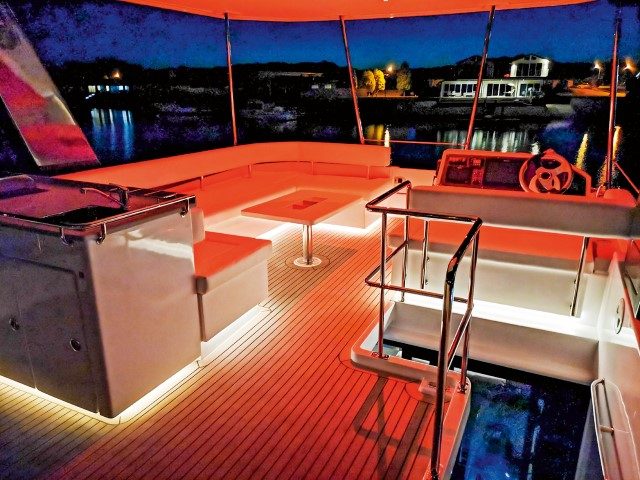
And speaking of the aft platform. This one’s fitted with a solid pair of tilt-down davits for the inflatable. Its greatest appeal is the electric motor that does the drudge work – hoisting and lowering the 3.5m tender at the touch of a button. No need to compromise your dignity.
As is typical with powercats, the Leopard 43’s foredeck is solid (rather than netting) – and it creates a massive, flat area. It’s an ideal space for raucous teenagers and is accessed via wide side-decks. But – it’s also accessible via a full-height door at the front of the saloon. So in cocktail mode when friends have joined you for a sunset cruise, carrying drinks/canapés between galley and foredeck is quick and convenient – no need to use the side decks.
A flight of stairs – starboard side of the cockpit – takes you to the flybridge. Up there you’re rewarded with 360° forever views, plenty of seating and more of the teak decking. A stylish U-shaped settee (check out the padded backrests!) surrounds a coffee table. At the aft end of the settee is a semi-island console with sink and electric grill, and a small fridge below.

Despite its size, the small, racy wheel at the helm station presents effortless steering and the comprehensive Raymarine/Yanmar instrumentation displays everything you need to know – at a glance. It’s a plush helm station and on a hot summer’s day a great place to appreciate the wind in your hair (assuming, of course, you have sufficient hair).
That said, these cats are designed mainly for the charter market (think Caribbean and Med) where the breeze in your face offers welcome respite from the heat. In New Zealand, an open flybridge is not always practical – Wayne and Helen are already investigating options for enclosing the area with solid glass or acrylic. The Leopard factory doesn’t offer an enclosed flybridge option.
It’s also worth noting the clever use of LED mood lighting throughout the vessel – up on the flybridge it’s red – designed to make guests feel seductive and irresistible on hot, sultry evenings.
But the best part of the flybridge (and possibly my favourite Leopard 43 feature) is its spacious sunbed just forward, through the centre walkway. With Raymarine in charge of the helm, it’s a coveted spot for surveying the passing show. There are even drinks holders either side.
Interior
The space-to-swing-a-cat expansiveness continues inside, the pale upholstery and panelling accentuating the sense of airiness – all complemented by natural light flooding in from numerous windows. Very clean, crisp and contemporary – and an easy palette to dress with colourful cushions, rugs and objets d’art.
Leopard 43s are available in two configurations – a three-cabin/two-bathroom version, and a four-cabin/two-bathroom alternative. The latter’s geared to the bareboat charter market.
Sirène is the former – the owner version – where the port hull comprises two double cabins (forward and aft) separated by a shared bathroom midships. The entire starboard hull is devoted to unabashed decadence – a double cabin aft, a spacious bathroom forward (electric toilet and shower) and, midships, a dressing room with a vanity. It’s ultra-stylish – a luxurious area equipped with a discreet sliding door to shut out the late-night revellers in the saloon.
On a more practical note, the forward end of the shower compartment conceals a washer-dryer unit. Clever use of space.
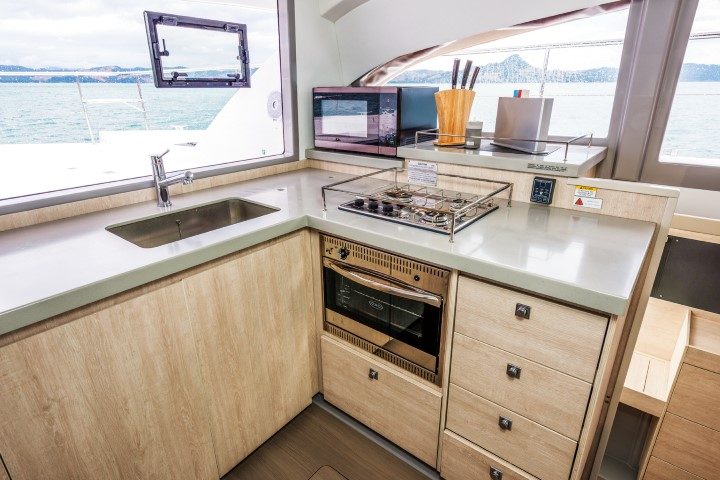
Saloon, galley and cockpit are well-integrated thanks to the sliding door and large window in the saloon’s rear bulkhead. With both fully open it effectively becomes one indoor-outdoor area with a warm sense of ‘inclusiveness’.
At the saloon’s starboard galley the chef has masses of bench space for gastronomic experimentation – a wide food-preparation area against the forward bulkhead, with a nearby microwave and three-burner cooker/oven in attendance. All designed with easy-cleaning surfaces.
Further back, below the bench top, is a double-decker pull-out drawer fridge and freezer. Lockers and drawers abound – with more storage in the saloon sole. To port is a square folding-leaf table serviced by an L-shaped settee, with an additional (movable) bench stool. Mounted on a pedestal, the table can be lowered to create a large, emergency bed for any guests unable to find their tenders.
Up front on the saloon’s port side is another clever Leopard feature: a second ‘helm’ station/chart table, though it’s not really a helm. Equipped with a second set of those smooth throttles/shifts, it’s more for manoeuvring the vessel when anchoring or coming alongside. And it works a treat thanks to that door in the forward bulkhead.
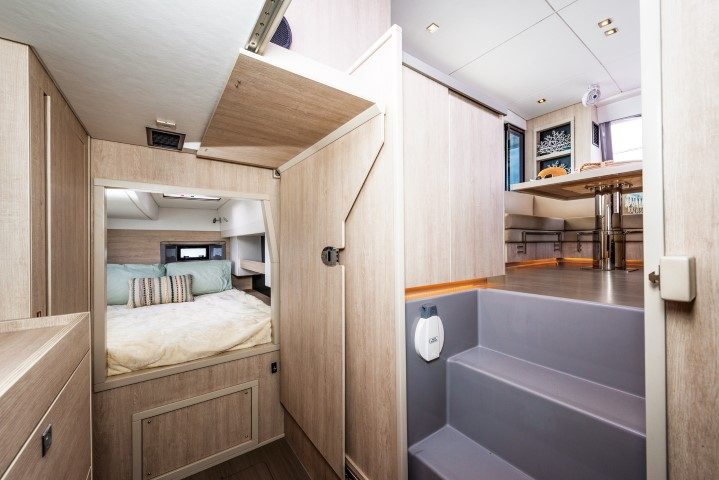
It means the skipper can control the anchoring operation precisely as the windlass’ wired remote is right there. More importantly, it’s useful for coming alongside when short-handed: the skipper can quickly move forward to secure a bow line, rather than run back through the cockpit and along the side deck.
This helm station is also likely to become Grand Central for phones and cameras – it’s equipped with four USB ports.
Electrics
The best way to get a feeling for Sirène’s electrical infrastructure is to examine the comprehensive (and precisely-labelled) control panel at the aft end of the saloon. It will tell you that the cat’s equipped with numerous accessories designed for long-range cruising in comfort – a watermaker, for example, as well as air-conditioning (and heating) systems for the entire vessel.
A 10kVa Fischer Panda generator has been installed for when the smoothie-making machine is in hot demand, but under normal circumstances the three AGM house batteries (more than 600 amp-hours in total) drive an inverter without fuss. Charging those batteries is supplemented by a pair of 100-watt solar panels fitted to the flybridge roof.
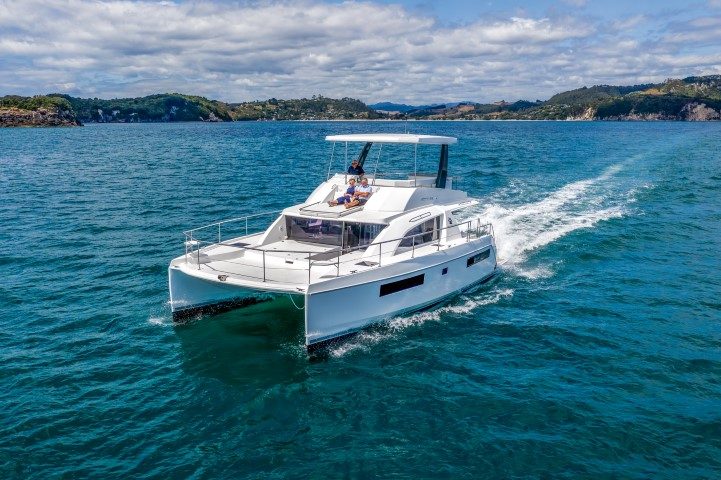
The Leopard 43 exudes a sense of solid sturdiness – and vessels from the Robertson & Caine factory support this in a graphic way: many (particularly the sailing cats) are delivered to destinations around the world on their own bottoms. Sirène was delivered to Australia by ship but completed the rest of the journey to Auckland (via Lord Howe Island) under her own steam.
She’s an elegant feline, easily adapted to different modes – hosting multiple generations of the family over Christmas, or opting for a few of your close friends, with a different lighting configuration, and plenty of fine wine.
Tailored for serene entertaining.
‘Behemoth’ is a word which springs to mind or, perhaps more nautically, ‘leviathan’.
White Pointer has earned the respect of discerning customers in New Zealand and Australia, attracting a loyal and ever growing following for its high-quality, rugged and totally dependable aluminium trailer boats.
The hardtop SP635 shares the same underpinnings as the popular SF 635 which was a completely new model back in 2020.
The pride and joy of a multi-generational family, Bliss resides on a pier that’s home to a couple of other Elite motor launches – Sandspit Marina is a hot-spot for the Bill Upfold-designed vessels, with several calling this small marina home.